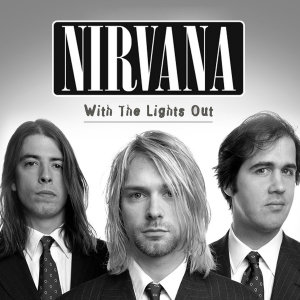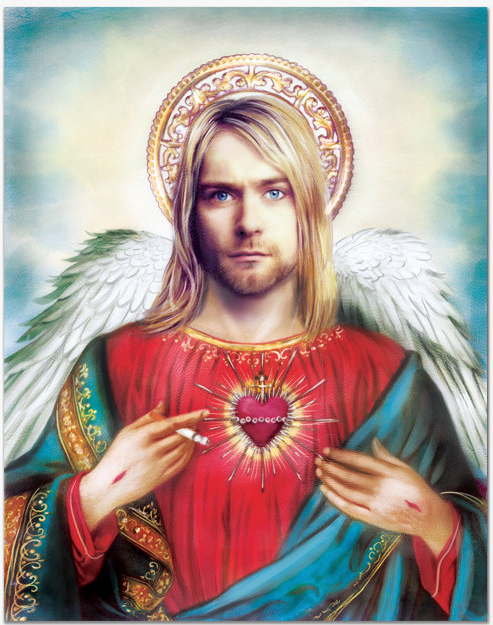Artwork by DIRTY LOLA
NEW YORK MAGAZINE: Like Elvis, the Beatles, and Easy Rider before them, Nirvana instantly inverted the status quo. They flipped the axis on what mainstream and alternative meant, usurping the likes of Michael Jackson, Garth Brooks, and Guns N’ Roses at the top of the charts. Seemingly overnight, the music industry was suddenly chasing down the likes of Royal Trux, Steel Pole Bath Tub, and the Jesus Lizard so as to hand them suitcases of cash. For a few years, corporate rock had to pretend to be college rock. Fashion laughably wrapped itself in flannel and heroin chic, Hollywood set a rom-com in the midst of Seattle’s music scene, while a Sub Pop receptionist outed the “lamestains” in the “lamestream” media and Cobain graced the cover of Rolling Stone with a T-shirt reading “Corporate Magazines Still Suck.” Nirvana pulled back the veil to reveal such major institutions to be the hapless fools they were then and still are now.
Musically, Nirvana was a cagey mix of ludicrously macho classic rock, scummy punk, irrefutable pop hooks, and precocious indie twee. The band remains a gateway for new listeners, a bridge between generations and extremes. Cut your teeth on the Beatles and Nirvana can quickly usher you toward Flipper and the Melvins. If you’re into your older sister’s Aerosmith and Led Zeppelin records, Nirvana could open you up to Bikini Kill and Daniel Johnston.
Teenage angst paid off well, as Kurt Cobain once humblebragged, but we fans received something in return, something that it took decades for many of us to fully appreciate. Tucked away in Journals, Kurt Cobain wrote a letter to his ex-girlfriend Tobi Vail (of Bikini Kill) about how he perceived his band in the American cultural landscape. “It’s almost impossible to de-program the incestually-established, male oppressor, especially the ones who’ve been weaned on it thru their families … like die-hard NRA freaks and inherited corporate-power mongrels … But there are thousands of green minds, young gullible 15-year-old boys out there just starting to fall into the grain of what they’ve been told of what a man is supposed to be, and there are plenty of tools to use. The most effective tool is entertainment.” MORE
PREVIOUSLY: Sometime between Bleach and Nevermind, Kurt Cobain repurposed the Pixies’ patented lulling verse/volcanic chorus dynamic to prop up the enormous chip on his shoulder during the Frankenstein-ish gene-splicing experiments with the Beatles and Black Sabbath he was conducting out in rainy Seattle. The monster would, of course, rise from the slab and kill its creator in the end. In 1994, when Cobain bit down on the barrel of a 20-gauge shotgun and pulled the trigger, he killed a lot of birds with one stone. He widowed his wife and essentially orphaned his daughter, his art and an entire generation of disciples who hung on his every word. He also managed to freeze-frame his legacy into the hallowed halls of martyrdom, ensuring that every future assessment of his work would be filtered through the grim prism of his self-inflicted crucifixion.
Doled out by the keepers of his flame to re-up the visitorship to the shrine of St. Kurt, With the Lights Out is a four-disc barrel-bottom-scraping time capsule of his electrifying tantrums and territorial pissings, and when he felt like it, his seemingly bottomless capacity for heart-shaped melodicism. There are three moments on this collection of 80-some  tracks that make the hair on the back of my neck stand up: a demo version of “Rape Me” with a newborn Francis Bean Cobain crying throughout; a solo acoustic reading of “All Apologies” that has the same angel-wing flutter of John Lennon’s acoustic demo of “Strawberry Fields Forever”; and a filmed segment of the band in a Brazilian recording studio performing Terry Jacks’ maudlin ’70s soft-rock meisterwork “Seasons in the Sun”–with Cobain on drums, Dave Grohl on bass and Krist Novoselic on guitar–interspersed with home movie footage of the band members in younger days having joy and having fun, despite the growing sense that the hills they climbed were just seasons out of time.
tracks that make the hair on the back of my neck stand up: a demo version of “Rape Me” with a newborn Francis Bean Cobain crying throughout; a solo acoustic reading of “All Apologies” that has the same angel-wing flutter of John Lennon’s acoustic demo of “Strawberry Fields Forever”; and a filmed segment of the band in a Brazilian recording studio performing Terry Jacks’ maudlin ’70s soft-rock meisterwork “Seasons in the Sun”–with Cobain on drums, Dave Grohl on bass and Krist Novoselic on guitar–interspersed with home movie footage of the band members in younger days having joy and having fun, despite the growing sense that the hills they climbed were just seasons out of time.
Much of this material–home demo tapes, radio station performances and early acoustic versions of classic Nirvana tracks–has long been traded in the shadowy digital chop shops of file-sharing networks, but the true value in this enterprise is that, as you read this, a runny-nosed kid eating Froot Loops out of a dirty bowl in some flea-bitten double-wide in Cow’s Ass, Ind., is listening to With the Lights Out and realizing he can purge all his rage, self-loathing and ham-fisted fumbling for grace into three serrated guitar chords and a primal yowl. And one day he–or for that matter, she–will change music once again. — JONATHAN VALANIA
RELATED: Steve Albini On Making In Utero Etc.

